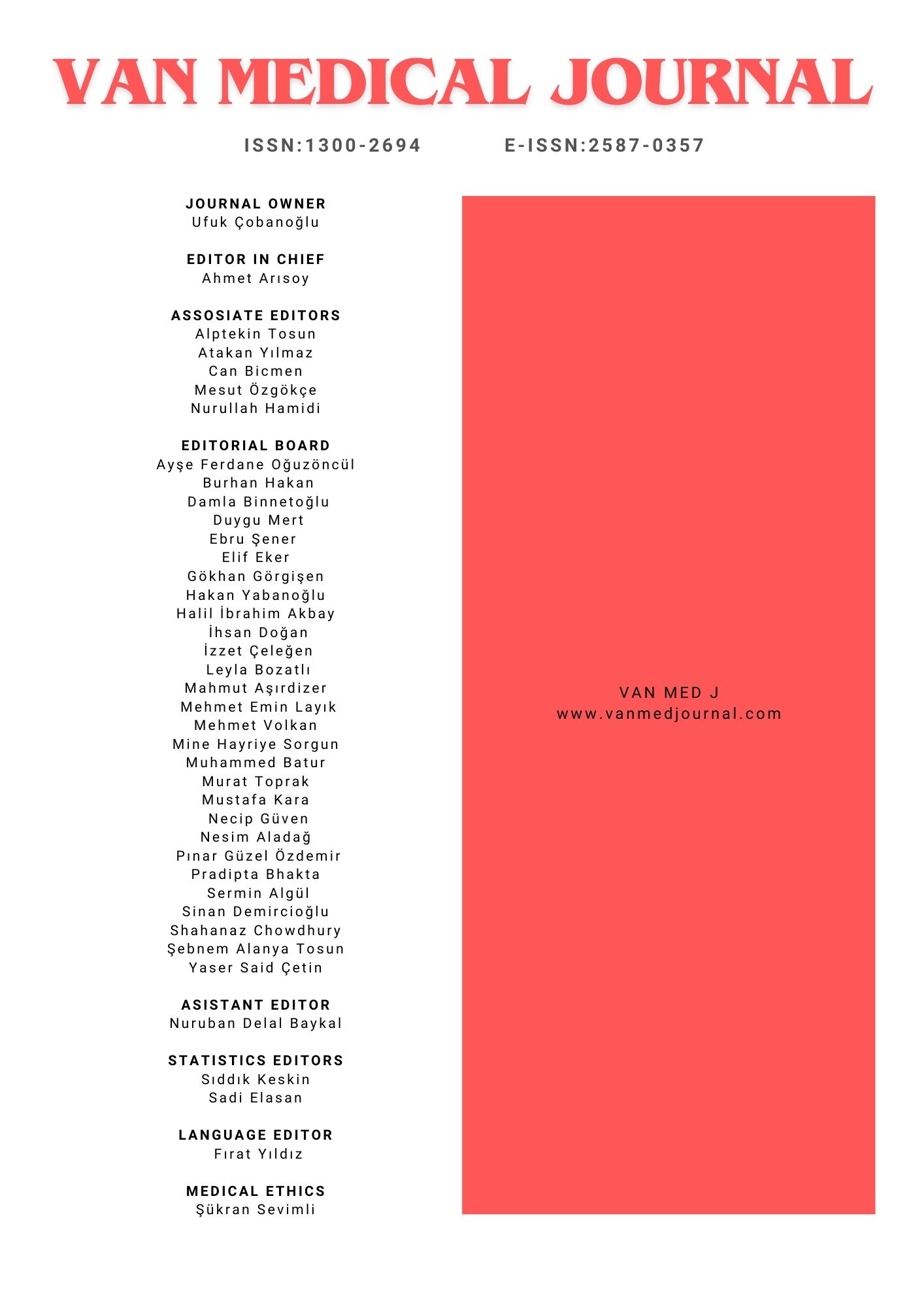The Anaerobic bacteria isolated from various clinical specimens and their antibiotic susceptibilities
Hamza Bozkurt1, Hüseyin Güdücüoğlu2, Yasemin Bayram3, Selma Gülmez4, Nihat Kutulay5, Edibe Nurzen Bozkurt1, Mustafa Berktaş61Yüzüncü Yıl Üniversitesi, Tıp Fakültesi, Mikrobiyoloji ve Klinik Mikr. Anabilim Dalı, Van.2Yüzüncü Yıl Üniversitesi, Tıp Fakültesi, Mikrobiyoloji ve Klinik Mikr. Anabilim Dalı, Van.
3Yüzüncü Yıl Üniversitesi, Tıp Fakültesi, Mikrobiyoloji ve Klinik Mikr. Anabilim Dalı, Van.
4Yüzüncü Yıl Üniversitesi, Tıp Fakültesi, Mikrobiyoloji ve Klinik Mikr. Anabilim Dalı, Van.
5Yüzüncü Yıl Üniversitesi, Tıp Fakültesi, Mikrobiyoloji ve Klinik Mikr. Anabilim Dalı, Van.
6Yüzüncü Yıl Üniversitesi, Tıp Fakültesi, Mikrobiyoloji ve Klinik Mikr. Anabilim Dalı, Van.
In this study, anaerobic bacteria recovered from the samples which were sent to our Clinical Microbiology Laboratory between January, 2002 and December, 2002 were evaluated according to their strains, where they were isolated from and antibiotic susceptibilities. Results: A total of 238 samples were obtained from various clinics during the study period and anaerobic bacteria were recovered from 67 of the samples. 28 (41.8 %) of the isolated 67 anaerobic bacteria were identified as Ruminococcus productus and accepted as members of the normal flora. The other 39 anaerobic bacteria were accepted as pathogens. These pathogen bacteria were isolated from samples of blood (11), abscess (10), vagina (6), peritoneal fluid (4), ear (3), pleural fluid (2), endometrium (2) and lung abscess. The isolated anaerobic bacteria were Actinomyces israelii (14), Propionibacterium acnes (9), Propionibacterium granulosum (1), Bacteroides ovatus (2), Bacteroides distasonis (2), Eubacterium rectale (1), Porphyromonas asaccharolyticus (1), Lactobacillus fermentans (2), Fusobacterium varium (1), Prevotella intermedia (2), Prevotella oralis (1), Prevotella ruminicola (2), Peptostreptococcus spp.(2). As a result of the antimicrobial susceptibility tests performed on the isolated anaerobic bacteria the resistance rates were as follows; chloramphenicol 12.8 %, cefoxitin 33.3 %, tetracycline 35.9 %, cefotaxime 38.4 %, carbenicillin 48.7 %, clindamycin 56.4 % and metronidazole 94.9 %. The most frequent anaerobic bacteria isolated from various samples were detected as Actinomyces israelii (35.9 %) and Propionibacterium acnes (23.1 %) and the most effective antimicrobials were chloramphenicol (87.2 %) and cefoxitin (66.7 %).
Keywords: Anaerobic bacteria, antibiotics, antimicrobial susceptibilityKlinik Örneklerden İzole Edilen Anaerob Bakteriler ve Antibiyotik Duyarlılıkları
Hamza Bozkurt1, Hüseyin Güdücüoğlu2, Yasemin Bayram3, Selma Gülmez4, Nihat Kutulay5, Edibe Nurzen Bozkurt1, Mustafa Berktaş61Yüzüncü Yıl Üniversitesi, Tıp Fakültesi Mikrobiyoloji Anabilim Dalı, Van2Yüzüncü Yıl Üniversitesi, Tıp Fakültesi, Tıbbi Mikrobiyoloji Anabilim Dalı, Van
3Yüzüncü Yıl Üniversitesi Tıp Fakültesi, Tıbbi Mikrobiyoloji Anabilim Dalı, Van
4Yüzüncü Yıl Üniversitesi, Tıp Fakültesi, Mikrobiyoloji ve Klinik Mikr. Anabilim Dalı, Van
5Yüzüncü Yıl Üniversitesi, Tıp Fakültesi, Mikrobiyoloji ve Klinik Mikr. Anabilim Dalı, Van.
6Yüzüncü Yıl Üniversitesi, Tıp Fakültesi, Tıbbi Mikrobiyoloji AD, Van
Bu çalışmada; 2002 yılı içerisinde Klinik Mikrobiyoloji Laboratuvarına gelen örneklerden izole edilen anaerob bakterilerin türlerine, izole edildikleri bölgelere ve antibiyotik duyarlılıklarına göre değerlendirilmesi amaçlanmıştır. Bu süre içerisinde laboratuvarımıza anaerob kültür amacıyla toplam 238 örnek kabul edilmiş ve bu örneklerden 67 (%28.2)’sinden anaerob bakteriler izole edilmiştir. İzole edilen 67 anaerob bakterinin 28 (%41.8)’i Ruminococcus productus olarak identifiye edilmiş ve flora elemanı olarak kabul edilmiştir. Kalan 39 (%58.2) suş ise patojen olarak kabul edilmiş olup bu anaerob bakteriler; kan (11), abse (10), vajen (6), periton sıvısı (4), orta kulak (3), plevral sıvı (2), endometrium (2), akciğer absesi (1) örneklerinden izole edilmişlerdir. İzole edilen 39 patojen anaerob bakterilerin tür dağılımında; Actinomyces israelii (14), Propionibacterium acnes (9), Propionibacterium granulosum (1), Bacteroides ovatus (2), Bacteroides distasonis (2), Eubacterium rectale (1), Porphyromonas asaccharolyticus (1), Lactobacillus fermentans (2), Fusobacterium varium (1), Prevotella intermedia (2), Prevotella oralis (1), Prevotella ruminicola (1), Peptostreptococcus spp (2) saptandı. Anaerob bakterilerin kloramfenikole %12.8, sefoksitine %33.3, tetrasikline %35.9, sefotaksime %38.4, karbenisiline %48.7, klindamisine %56.4 ve metronidazole %94.9 oranlarında direnç gösterdikleri saptandı. Bu sonuçlara göre anaerob bakteriler arasında en sık Actinomyces israelii (% 35.9) ve Propionibacterium acnes (%23.1), en duyarlı antimikrobiyaller olarak da kloramfenikol (%87.12) ve sefoksitin (%33.3) olduğu tespit edilmiştir.
Anahtar Kelimeler: Anaerob bakteri, antibiyotik, antimikrobiyal duyarlılıkManuscript Language: Turkish

